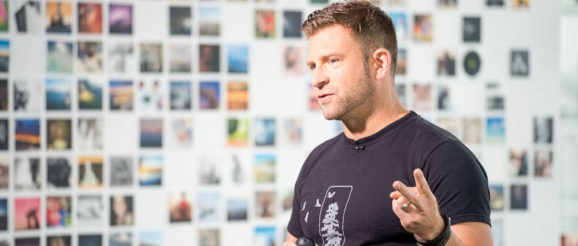Innovation is a Social Process – and Collaboration is Key | Chase Jarvis Photography

When you think of “innovation,” what comes to mind? A turtleneck-clad “creative” sketching impossibly elegant, otherworldly product designs? Maybe a Minority Report-like scene of a scientist solving complex equations and diagrams on some futuristic computer interface, or a group of elite hackers sequestered in a think tank coding up the next generation of algorithms?
If something along those lines popped into your head, you’re half right. Hard skills like design and engineering will always be crucial parts of the innovation process, but the world is increasingly becoming aware that they’re not a complete solution on their own.
The next frontier of innovation
Let me assert one thing: innovation isn’t “technology.” Innovation is people coming together to solve tough problems in new ways. That is — counter to some understandings — innovation is fundamentally a SOCIAL process, and the next evolution of innovation-driven organizations (whether they’re small businesses, enterprises, or departments within larger companies) will be defined by emphasizing soft skills like emotional intelligence and interpersonal communication as much as traditional, hard skills.
The reason why is simple: the low-hanging fruits are gone. The easy wins have been claimed. The kind of groundbreaking innovations that will create the next Uber, the next tool for repairing DNA, or framework for addressing income inequality can only come from looking at the world from several perspectives at once— engineering, finance, design, marketing, moral, legal, and so forth– and synthesizing them into something that’s greater than the sum of the parts.
The big wins of tomorrow fundamentally require world-class teams operating in perfect lockstep. They’re simply more than any of us can tackle on our own.
I want to be very clear here: I am NOT advocating compromise. All too often “compromise” simply means that the team settled for the lowest common denominator in the interest of consensus- aka “designed by committee,” which is a recipe for mediocrity and the kiss of death for innovation. What I’m advocating is collaboration, which in my view is a very different beast.
Words of wisdom from Vanessa Van Edwards on how to deal with difficult people (check out her CreativeLive class for more)
People skills
If you’ve ever been part of a team tasked with innovation (especially one that’s part of a large company) then you know what I’m talking about when I say that innovation is a social process and that the role of human relationships in innovation is no less vital than that of technical breakthroughs.
While I’m not saying it’s easy by any means, coming up with the idea is rarely the hardest part of innovation. The place where innovation most often stalls out is in nurturing it from the seed of an idea to a fully grown product– and the key to hurdling that barrier is usually getting buy-in from the right people inside the company. Why? Because innovation doesn’t happen in a vacuum. Game-changing ideas are by nature complex, and very few of us have the expansive skill set it would take to execute them singlehandedly. Getting an idea across the finish line takes collaboration.
That means communicating your vision to other stakeholders in terms that will help them see the potential, help you solve problems that are outside your skillset, polish it in ways you didn’t think of, and champion the idea in places where your influence is limited.
If you’re an engineer, collaboration could mean enlisting a designer to help you bring the idea to life in a way that looks, feels and works beautifully. If you’re a designer, it could mean getting the help of someone in finance to model the revenue the idea might generate or a salesperson to better understand the nuances of your customers’ use cases.
The keys to unlocking this kind of frictionless collaboration that allows teams to innovate without compromise are the soft skills which are fast becoming top priorities for business leaders: emotional intelligence, interpersonal communication, empathy and conflict resolution.
Hard skills are still vital
With all that said, I do want to emphasize that hard skills are still critical– although the definition of “hard skills” has shifted from its traditional (and limiting) scope of engineering and related disciplines.
In a world where the market increasingly values world-class creative skills — design, branding, UX, photography, video, copywriting and the like — these are an integral part of any innovation-focused team. Great execution on the above is no longer just window dressing, but a fundamental component of the innovation process.
So while soft skills are likely to be a big point of emphasis in coming discussions about innovation, keep your hard skills sharp as well. Tomorrow’s innovators must be great along both dimensions.
Looking ahead
Innovation will continue to be the focal point of business, and innovation-driven companies will increasingly look to empower their teams with not just the generic skills that have defined innovation in the past, but the soft and hard skills that define its future.
While I consider myself a lifelong student, this year I’ll be renewing my own personal commitment to learning and I’m inviting you to do the same. Pursue whatever you’re most passionate about via the unprecedented array of education options available to us today (many of them free): whether it’s via my company CreativeLive or other great companies like Babbel and Treehouse, there’s never been a better time to be a student.
Originally published on Virgin
